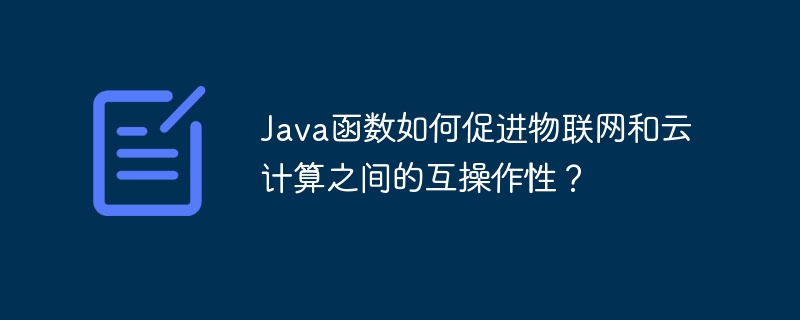
Java functions serve as a bridge for IoT and cloud computing interoperability by providing a common language. It can: Convert IoT device data formats. Adapt communication protocol. Handle IoT device events. Practical case: A Java function listens to the temperature data in the MQTT broker, converts it into JSON format, and stores it in the cloud database to achieve seamless interoperability between IoT devices and cloud platforms.

Java Functions: A Bridge to IoT and Cloud Computing Interoperability
Introduction
The Internet of Things (IoT) and cloud computing are two powerful forces that complement each other in the modern technology landscape. However, interoperability between them is often hampered by different communication protocols and data formats. Java functions can serve as a bridge, facilitating seamless integration between the two technologies by providing a common language and programming environment.
The concept of Java functions
Java functions are reusable blocks of code that can be easily deployed on cloud platforms. They are stateless, which means they do not store any internal data. Instead, they receive input data, perform defined operations, and return output.
Java functions for IoT and cloud computing interoperability
Java functions facilitate interoperability between IoT and cloud computing in various scenarios, Includes:
Practical Case
The following is a practical case showing how Java functions can be used for IoT and cloud computing interoperability:
Problem: An IoT device collects temperature data and publishes it to an MQTT broker. This data needs to be converted to JSON format and stored in the cloud database.
Solution:
Java function code:
import com.google.cloud.functions.HttpFunction;
import com.google.cloud.functions.HttpRequest;
import com.google.cloud.functions.HttpResponse;
import java.io.IOException;
import java.io.PrintWriter;
import java.nio.charset.StandardCharsets;
import java.util.logging.Logger;
public class MqttToDatabaseFunction implements HttpFunction {
private static final Logger logger = Logger.getLogger(MqttToDatabaseFunction.class.getName());
@Override
public void service(HttpRequest request, HttpResponse response)
throws IOException {
// 从请求正文中提取温度数据
String temperatureData = request.getReader().lines().collect(Collectors.joining());
// 将温度数据转换为 JSON 格式
String json = "{\"temperature\":" + temperatureData + "}";
// 将 JSON 数据发送到云数据库
// ...
// 将成功消息返回客户端
PrintWriter writer = new PrintWriter(response.getWriter());
writer.print("Data saved successfully.");
}
}This Java function is deployed on the cloud platform. Whenever temperature data is received in the MQTT broker, it will be automatically called. function. It transforms data and stores it in a cloud database, enabling seamless interoperability between IoT devices and cloud platforms.
By leveraging the versatility and portability of Java functions, developers can easily build applications and services that promote interoperability between IoT and cloud computing.
The above is the detailed content of How can Java functions facilitate interoperability between IoT and cloud computing?. For more information, please follow other related articles on the PHP Chinese website!
 What are the applications of the Internet of Things?
What are the applications of the Internet of Things?
 The m2m concept in the Internet of Things
The m2m concept in the Internet of Things
 Which platform is better for virtual currency trading?
Which platform is better for virtual currency trading?
 How to install the driver
How to install the driver
 How to replace all ppt backgrounds
How to replace all ppt backgrounds
 The difference between python and pycharm
The difference between python and pycharm
 How to check cpu usage in linux
How to check cpu usage in linux
 All uses of cloud servers
All uses of cloud servers




